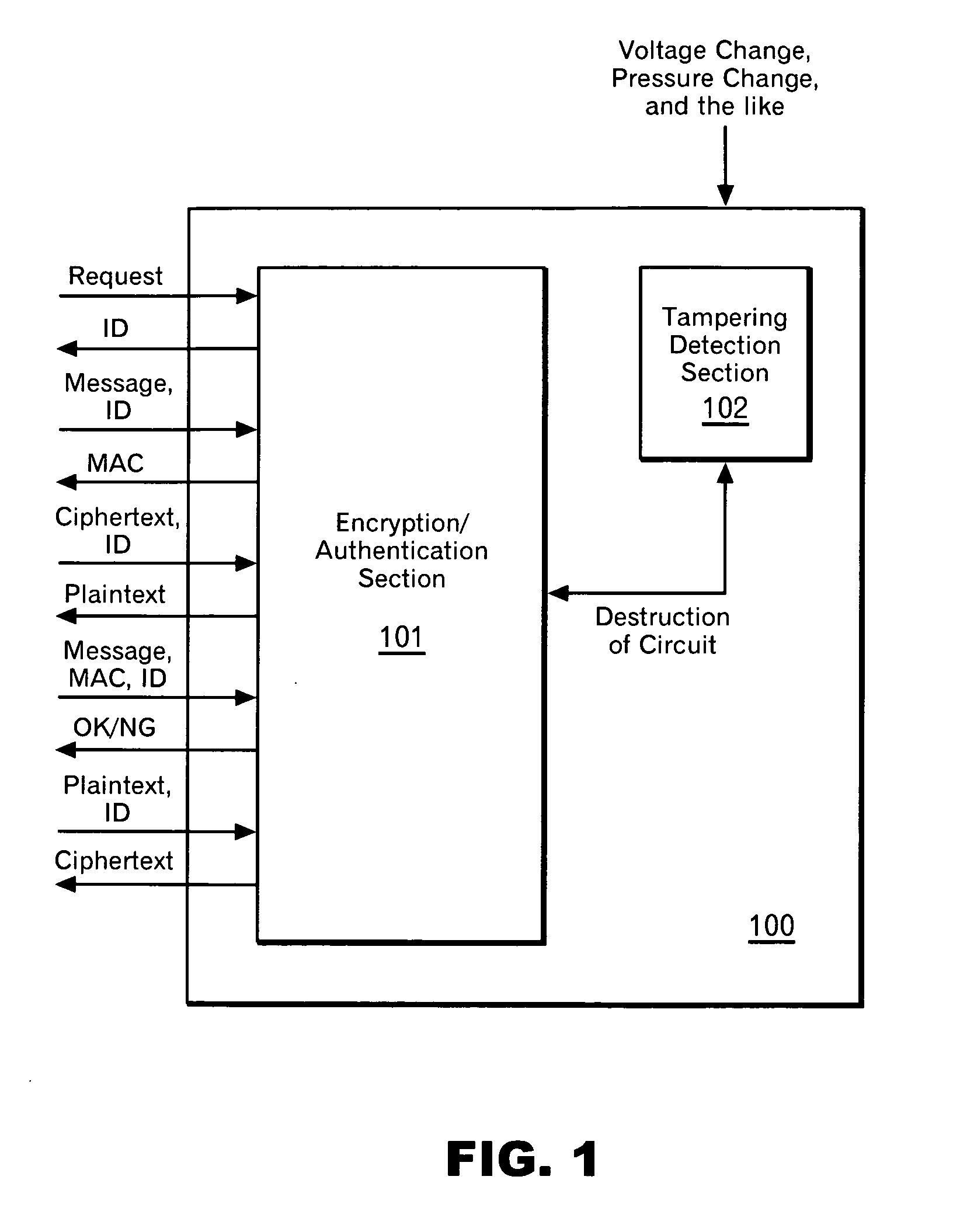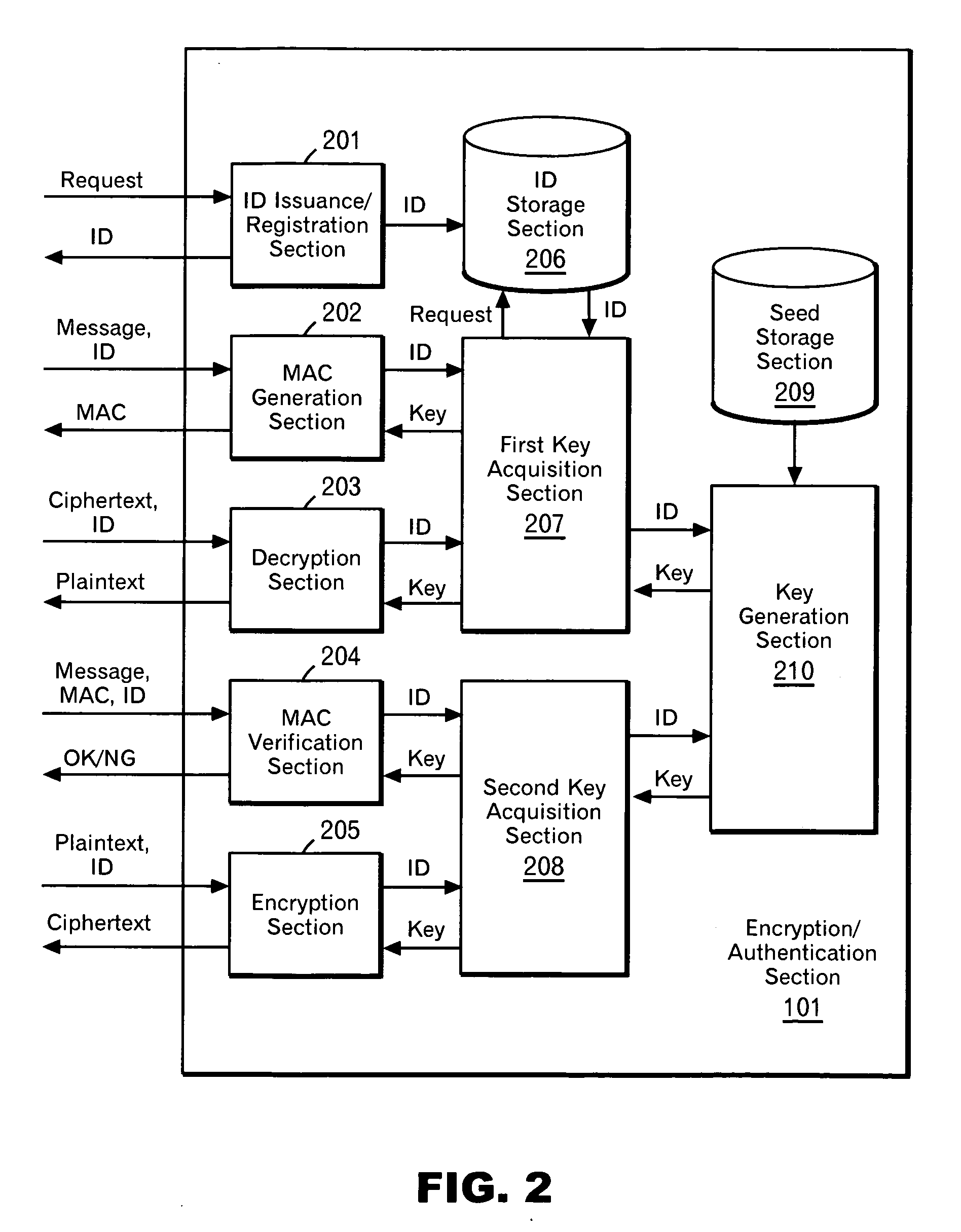Pseudo public key encryption
a public key and encryption technology, applied in the field of public key encryption, can solve the problems of high cost of calculation, high cost of operation, and high cost of computation required for rsa cryptography with a large bit number, and achieve the effect of low cost and low cos
- Summary
- Abstract
- Description
- Claims
- Application Information
AI Technical Summary
Benefits of technology
Problems solved by technology
Method used
Image
Examples
embodiment 1
[0060] Description will be made on an embodiment in the case where a sufficient number of keys can be stored in the system 100 (including each interface and sending-receiving protocols) with the use of FIG. 3. It is assumed that a user A and a user B communicate with each other using the system 100 in FIG. 1 (hardware A and hardware B). It is also assumed that a sufficient number of keys are stored in the system 100, each of which is given an ID specific thereto. If the pieces of hardware are the same, mapping of the ID and the key is also the same.
[0061] The user A requests an ID from the hardware A (310). The hardware A selects an ID (hereinafter referred to as ID-A) at random from an ID space (320), and returns the ID to the user A. The ID is also stored in an ID storage section. The user A publishes the ID-A. Meanwhile, the user B has also performed the same processing as the user A. That is, the user B requests an ID from the hardware B (310). The hardware B selects an ID (her...
embodiment 2
[0064] Actually, it is often impossible to a storage capacity enough to store a sufficient number of key. Description will be made on an embodiment in the case where a sufficient number of keys cannot be stored in the system 100 with the use of FIG. 4. Only one value (hereinafter referred to as a seed) is stored in the system 100 so that a key is generated from the seed and an ID as appropriate. Any hash algorithm (for example, SHA-1) is used so that a hash value of (ID|seed) is used as a key. In this case, the procedure for the user A to create a message to be sent is as follows.
[0065] The procedure from the step where the users A and B request an ID and the hardware selects and stores an ID to the step where each user publishes his own ID is the same as that of the embodiment described above. Suppose that the user A sends a message to the user B. When creating a message to be sent, the user A hands over the message and the ID-A to the hardware A and requests generation of a MAC. ...
embodiment 3
[0067] In the two embodiments described above, there is shown a case where an ID is selected at random. Next, an example of applying the present invention to an ID-based cryptosystem with the use of FIG. 5. In this case, the processing to be performed by the user A in advance is as follows. The user A hands over the hardware A and the ID-A to an ID storage body 520, and requests storage of the ID in the hardware (510). The ID storage body hands over the ID-A to the hardware A, and requests storage of the ID. The hardware A stores the ID-A in the ID storage section. The processing to be performed by the user B in advance is the same. That is, the user B hands over the hardware B and the ID-B to the ID storage body 520, and requests storage of the ID in the hardware (510). The ID storage body hands over the ID-B to the hardware B, and requests storage of the ID. The hardware B stores the ID-B in the ID storage section. The procedure for the user A to create a message to be sent and th...
PUM
 Login to View More
Login to View More Abstract
Description
Claims
Application Information
 Login to View More
Login to View More - R&D
- Intellectual Property
- Life Sciences
- Materials
- Tech Scout
- Unparalleled Data Quality
- Higher Quality Content
- 60% Fewer Hallucinations
Browse by: Latest US Patents, China's latest patents, Technical Efficacy Thesaurus, Application Domain, Technology Topic, Popular Technical Reports.
© 2025 PatSnap. All rights reserved.Legal|Privacy policy|Modern Slavery Act Transparency Statement|Sitemap|About US| Contact US: help@patsnap.com



